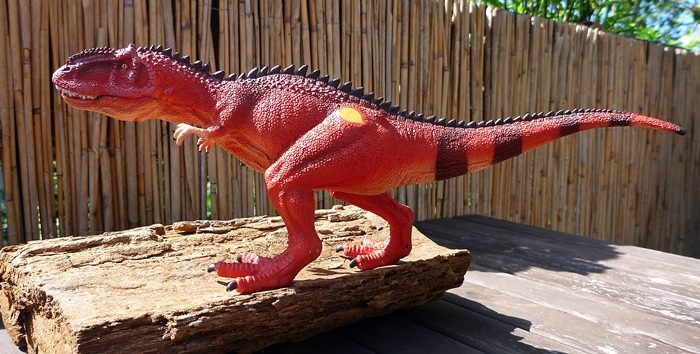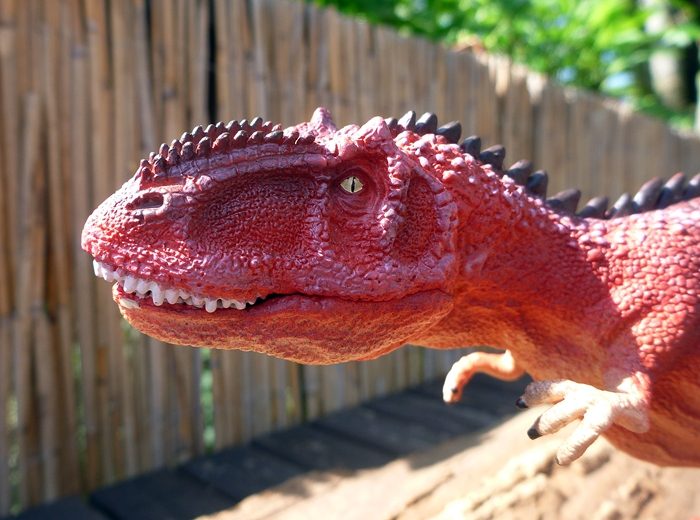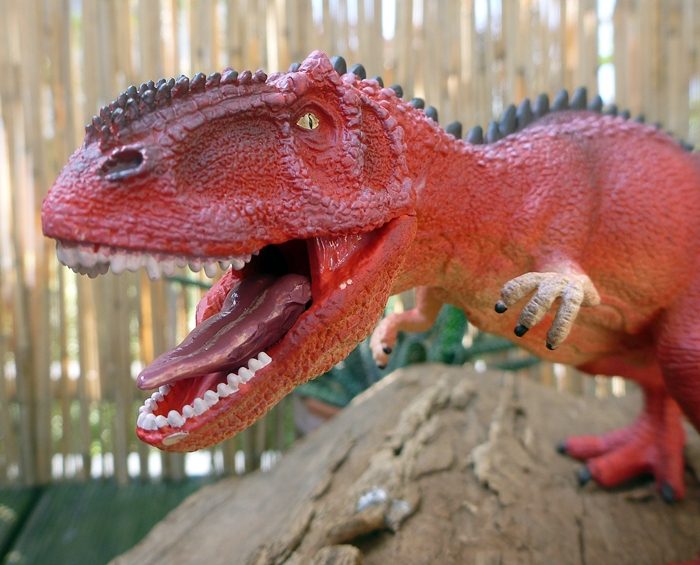Review and photos by Lanthanotus, edited by Suspsy
Large carnivores are always worth a headline, be it a shark attack or a prehistoric discovery in a country as neglected by international news media as Australia. Back in 1995 the world’s public was introduced to a dinosaur species which had been discovered two years before in the endless wastes of Patagonia by Rubén Dario Carolini, who is also the species’ namesake: Giganotosaurus carolinii. This immense carcharodontian theropod was fit to rival T. rex and therefore immediately gained a lot of popularity. With an estimated length of more than 12 or even 13 metres the species is more or less on par with our all time favourite theropod, but being built comparably lighter and less robust, the new competitor couldn’t push good ol’ Rex from its throne and gain a leading role in a movie or such. But Giganotosaurus does not need such media hype and fame for being awesome. After all, it’s an animal that evolved to hunt down the largest land dwelling prey that ever roamed the earth. Back in the Late Cretaceous, most surviving sauropods continued to thrive in what one day would be South America and species as Argentinosaurus grew to tremendous sizes. It was this was the presumed prey of the specialized Giganotosaurus. At an estimated top speed of 50 km/h, this flesh-eating giant probably hunted in packs in a hit-and-run strategy, biting and ripping parts of flesh out of their towering prey until it trembled and fell.


Now, how to pack such awesomeness into a lump of plastic? Several attempts have been made and Safari’s Carnegie Collection figure may be the best among them. German companies have not covered themselves with glory in the past when trying to depict this species (see here or here). The specimen described here is also a mixed bag, but certainly has its charms.


First of all, Ravensburger is not a classic toy figure producer, but a publisher of board games, books, and the like. For the last few years, Ravensburger markets the TipToi system. The central part of this system is the TipToi pen, an electronic device that can read tiny raster printed all over on the TipToi book sites and also on the orange spots on the marketed dinosaur figures. The toys, figures, and books “work” independently from another, so one can read and use the information provided on the raster of a figure after having downloaded (“free”) the information to the pen. Not being an owner of the pen yet, I can’t say how accurate the information about this dinosaur is. However, Ravensburger claims in its advertisements that such information would be up to date. Who actually sculpted the creatures is unknown to me, but style, general design, and quality makes me suggest it’s Schleich.


The TipToi Giganotosaurus measures 28 cm in total length and stands 10 cm tall. It is comparably heavy and produced from very sturdy plastic. The base color is a dark red which gives the theropod a nice, menacing look. The skin is very well detailed and decked with singly sculpted scales, dark pink scutes, and a dark, formidable ridge running along its spine. Muscle bulges, folds, and creases add to the liveliness of the model. The arms are reasonably small, three fingered, and not pronated, although the raised left arm makes the hand appear pronated. As is still quite common in paleoart these days, the skull is noticeably shrink-wrapped. This allows us to see how accurately the skull resembles the original, especially in its length and the far back jaw hinge. The eyes boast slit pupils, rendering our 2D vision apex predator a nocturnal hunter and the unfortunate short length of the lower jaw provides it with a remarkable overbite. Its toes are way too long and the tail is too short (and lacks a cloaca) which adds further negative points to the scientific accuracy. It does add a lot to the figure’s stability though. I deem the play value of this figure very high. As a kid, I would have loved this dino with its articulated jaw, despite the paint being rubbed off quite easily.


Overall, this rendition of Patagonia’s bane is far from being perfect, but still has a certain eye candy level with its size, color, detail, and agile, long striding pose. At a price tag of 16 to 24 €, it isn’t a cheap buy, but I guess one must keep in mind that you also purchase the downloadable information and sound of Giganotosaurus, though you’d need the TipToi pen (approx 35 €) to make use of that. Available in almost every German toy and lots of book stores and of course, Amazon and eBay.
Sent from my iPhone
Disclaimer: links to Ebay and Amazon on the DinoToyBlog are affiliate links, so we make a small commission if you use them. Thanks for supporting us!




So Schleich provides to another company models that are better than those they market under their own name? Epic fail.
I’m kind of torn on this one. The accuracy isn’t all that high…but there’s something about it. Maybe the fact that it’s one of two good Giganotosaurus figures, the other being the Carnegie figure.
I like it, too . . . it sort of looks like a dragon.
Thanks for your comment, stargatedalek,…
… while I have no source for stereoscopic vision (or the lack of) in Giganotosaurus and its orbitals (http://z4.ifrm.com/30233/130/0/p1147447/SGM_DIN_1_skull_alternate.svg) do not show the distinct position and orientation as T.rex’s (http://s6.postimage.org/696k80335/T_rex_skull_Greg_Paul.png), one should keep in mind, that skull bones alone allow only for a restricted reconstruction of soft tissue on the skull’s surface in the living animal. The eyeballs would bulge out of the orbital for a certain measure, possibly (an in my layman opinion highly probable considering Giganotosaurus’ lifestyle) allowing for a limited stereoscopic vision.
Interesting points, although Giganotosaurus’ eyesight still would not have come close to T. rex’s. All the restorations I’ve seen of the former have eyes facing out to the side.
I think that’s a Carcharodontosaurus skull in the first image. Since the eye sockets of Giganotosaurus point mostly sideways, my understanding is its binocular vision would be greatly limited, like it would be for Tarbosaurus, and its relatives Allosaurus and Carcharodontosaurus: http://ix.cs.uoregon.edu/~kent/paleontology/binocularVision/
I’ve found the paper about this. It says the skulls of Allosaurus and Carcharodontosaurus restricted their binocular vision to a region approximately 20°
wide, which is slightly less than that of extant crocodilians. The paper is quite comprehensive and worth reading if one’s interested in knowing more about this topic! The paper is Kent A. Stevens (2006). Binocular Vision in Theropod Dinosaurs It’s one of the references on the Wikipedia “Dinosaur vision” page. https://en.wikipedia.org/wiki/Dinosaur_vision
One thing to note is that Giganotosaurus shouldn’t actually have stereoscopic vision, its eyes should each look out to one side (like a deer).
Oops, meant to go back and remove that sentence and totally forgot. It’s done now.
You’re right, Schleich provides the Tiptoi-models